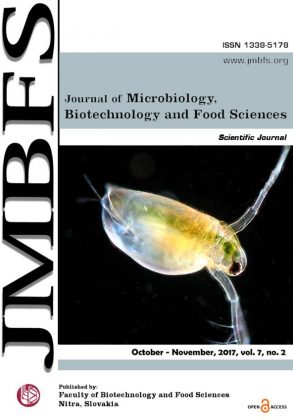BY-PRODUCTS OF DATES: OPTIMIZATION OF THE EXTRACTION OF JUICE USING RESPONSE SURFACE METHODOLOGY AND ETHANOL PRODUCTION
DOI:
https://doi.org/10.15414/jmbfs.2017.7.2.204-208Keywords:
by-product, optimal extraction, response surface analysis, fermentation, Saccharomyces cerevisiae, ethanolAbstract
The optimal extraction conditions were determined for by-product of date fruit by using the response surface design method. The obtained juice was used for the production of ethanol by fermentation of free cells of Saccharomyces cerevisiae. Optimal conditions for date juice extraction were found to be 80°C, 60 min, 1:2 dilution (fruit on water ratio) according to the result of response surface analysis (Equivalents glucose: 219 g.L-1). Saccharomyces cerevisiae showed a preference for glucose over fructose and among the tested total sugar concentrations, namely 50, 100, 174 and 358 g.L-1, 174 g.L-1 appeared to be the optimal amount, leading to 70 g.L-1 ethanol concentration after 66 h of fermentation,; while an inhibitory effect of a high sugar content, 358 g.L-1 of total sugars, namely about 2 mol/L of monosaccharide like glucose or fructose was also shown. Overall, this study suggested that date juice can be utilized for ethanol production.Downloads
Download data is not yet available.
Downloads
Published
2017-10-01
How to Cite
Chniti, S., Jemni, M., Bentahar, I., Ali Shariati, M., Djelal, H., Amrane, A., & Hassouna, M. (2017). BY-PRODUCTS OF DATES: OPTIMIZATION OF THE EXTRACTION OF JUICE USING RESPONSE SURFACE METHODOLOGY AND ETHANOL PRODUCTION. Journal of Microbiology, Biotechnology and Food Sciences, 7(2), 204–208. https://doi.org/10.15414/jmbfs.2017.7.2.204-208
Issue
Section
Food Sciences
License
Copyright (c) 2017 Sofien Chniti, Monia Jemni, Imen Bentahar, Mohammad Ali Shariati, Hayet Djelal, Abdeltif Amrane, Mnasser Hassouna

This work is licensed under a Creative Commons Attribution 4.0 International License.
All papers published in the Journal of Microbiology, Biotechnology and Food Sciences are published under a CC-BY licence (CC-BY 4.0). Published materials can be shared (copy and redistribute the material in any medium or format) and adapted (remix, transform, and build upon the material for any purpose, even commercially) with specifying the author(s).





